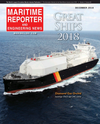
Page 41: of Maritime Reporter Magazine (December 2018)
Great Ships of 2018
Read this page in Pdf, Flash or Html5 edition of December 2018 Maritime Reporter Magazine
GREAT SHIPS
First of Six New LNG First of Six New LNG
Carriers Delivered to BPCarriers Delivered to BP
Photos: BP Shipping
BP Shipping took delivery of British with greater ? exibility in terms of the perature where it returns to liquid form ship discharges.
Partner, the ? rst of a half dozen new places where they can operate. and pumped back to the cargo tanks. BP Also, to minimize the threat of piracy, 173,400 cu. m. capacity lique? ed natu- Each of the new Partnership vessels is says these features add to an easy-to-op- the crew accommodation and engine ral gas (LNG) carriers to be delivered ? tted with two M-type, electronically- erate system, which burns less cargo gas room structures are designed and built through 2018 and 2019 from the DSME controlled, gas-injection (ME-GI) pro- than its predecessors and improves fuel to make it extremely dif? cult for poten- shipyard in South Korea. BP Shipping, pulsion systems and a full reliquefac- ef? ciency by around 25 percent. tial attackers to gain access. Some of the which launched a ? eet rejuvenation pro- tion system (FRS) designed by DSME. The vessels also feature signi? cant im- measures adopted include the removal gram in 2016 that includes 32 new ves- The slow speed tri-fuel engines, each of provements in hull design, which improve of external means of access to the ship’s sels for delivery over a three-year pe- which has its own shaft, propeller and speed and maneuverability, an exhaust bridge and other decks and the provision riod, said the six new Partnership class rudder, use compressed boil-off gas from gas recirculation system that reduces ni- of metal shutters to external windows.
ships will increase its ability to transport cargo tanks as fuel. trogen oxide emissions and a gas com- The new Partnership class tankers have
LNG in emerging new markets, such as While older LNG carriers use boil-off bustion system to minimize the potential been built big enough to take advantage
Pakistan, Jordan, Egypt and Bangladesh, gas to power either steam turbine or dual for releasing methane to the atmosphere. of the 2016 Panama Canal enlargement in addition to established markets, such fuel/diesel electric engines, the Partner- For waste management, engine room – a major global transit route for LNG as India, China, the U.S. and Australia. ship vessels have a ? ve-stage compres- sludges and waste water are processed to – their design, technology and environ-
British Partner and the ? ve other 295- sor that raises the pressure of the gas minimize the use of the incinerator and mental improvements mean they are also m ordered in October 2017 are bigger, from just above atmospheric pressure to galley waste passes through a macerator far more nimble than their Trader and more powerful and have a larger carry- 300bar to be sent to the engines for fuel and shredder, producing slurry that is re- Gem class predecessors. This means they ing capacity than the predecessor vessels or to the reliquefaction system. tained in a tank until it can be safely dis- will be able to load and discharge cargoes they are replacing. BP adds they’re also When the reliqufaction plant is in use, charged. Dry waste is treated with shred- at a far wider range of LNG ports and more ef? cient and, therefore, more envi- up to 70 percent of the gas discharged ders, glass crushers and a compactor for ? oating facilities worldwide, including ronmentally-friendly and cost-effective, from the compressor is cooled to a tem- baling and landing ashore minimizing those that are just coming on line.
www.marinelink.com 41
MR #12 (34-41).indd 41 MR #12 (34-41).indd 41 12/6/2018 10:49:04 AM12/6/2018 10:49:04 AM

 40
40

 42
42
